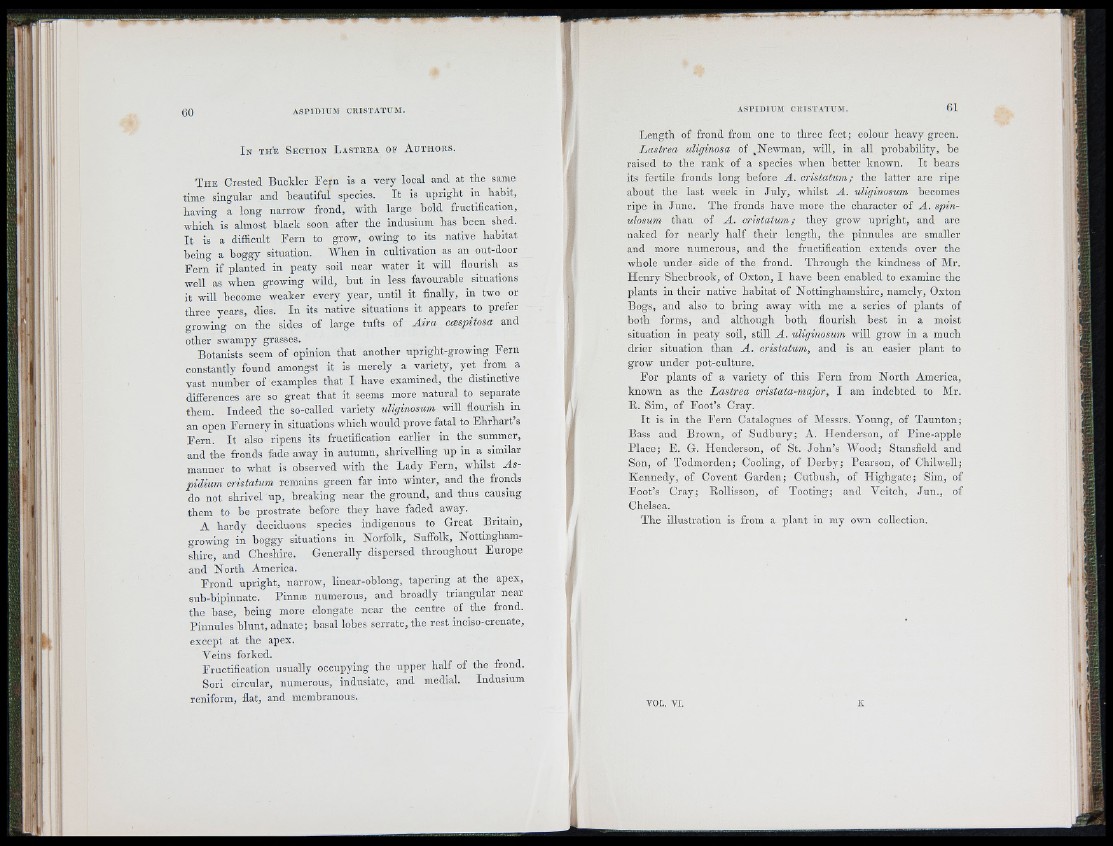
In t h e S e c t io n L a s t r e a o f A u t h o r s .
T h e Crested Buclder F e rn is a very local and at tire same
time singular and beautiful species. I t is upright in babit,
having a long narrow frond, with large bold fructification,
which is almost black soon after the indusium has been shed.
I t is a difficult Fe rn to grow, owing to its native habitat
being a boggy situation. W hen in cultivation as an out-door
Fe rn if planted in peaty soil near water it will flourish^ as
well as when growing wild, b u t in less favourable situations
it will become weaker every year, until it finally, in two or
three years, dies. In its native situations it appears to prefer
growing on the sides of large tufts of A ira cæspitosa and
other swampy grasses.
Botanists seem of opinion that another upright-growing Fern
constantly found amongst it is merely a variety, yet from^ a
vast number of examples that I have examined, the distinctive
differences are so great that it seems more natural to separate
them. Indeed the so-called variety uliginosum will flourish in
an open Fernery in situations which would prove fatal to F h rh a rt s
Fern. I t also ripens its fructification earlier in the summer,
and the fronds fade away in autumn, shrivelling up in a similar
manner to what is observed with the Lady Fe rn , whilst A s pid
ium cristatum remains green far into winter, and the fronds
do not shrivel up, breaking near the ground, and thus causing
them to be prostrate before tbey have faded away.
A hardy deciduous species indigenous to Great Britain,
growing in boggy situations in Norfolk, Suffolk, Nottinghamshire,
Snd Cheshire. Generally dispersed throughout Europe
and No rth America.
Frond upright, narrow, linear-oblong, tapering at the apex,
sub-bipinnate. Pinnæ numerous, and broadly triangular near
the base, being more elongate near the centre of the frond.
Pinnules blunt, adnate; basal lobes serrate, the rest inciso-crcnate,
except at tlie apex.
Veins forked.
Fructification usually occupying the upper half of the frond.
Sori circular, numerous, indusiatc, and medial. Indusium
reniform, flat, and membranous.
Length of frond from one to three feet; colour heavy green.
Lastrea uliginosa of _ Newman, will, in all probability, be
raised to the rank of a species when better known. I t bears
its fertile fronds long before A . cristatum; the latter are ripe
about the last week iu July , whilst A . uliginosum becomes
ripe in June. The fronds have more the character of A . spinulosum
than of A . cristatum; they grow upright, and are
naked for nearly half their length, the pinnules are smaller
and more numerous, and the fructification extends over the
whole under side of the frond. Through the kindness of Mr.
Plenry Sherbrook, of Oxton, I have been enabled to examine the
plants in their native habitat of Nottinghamshire, namely, Oxton
Bogs, and also to bring away with me a series of plants of
both forms, and although both flourish best in a moist
situation in peaty soil, still A . uliginosum will grow in a much
drier situation than A . cristatum, and is an easier plant to
grow under pot-culture.
For plants of a variety of this F e rn from North America,
known as the Lastrea cristata-major, I am indebted to (Mr.
K. Sim, of Foot’s Cray.
I t is in the Fern Catalogues of Messrs. Young, of Taunton;
Bass and Brown, of Sudbury; A. Henderson, of Pine-apple
Place; E. G. Henderson, of St. Jo h n ’s Wood; Stansfield and
Son, of Todmorden; Cooling, of Derby; Pearson, of Chilwell;
Kennedy, of Coveiit Garden; Cutbush, of Highgate; Sim, of
Foot’s Cray; Kollisson, of Tooting; and Veitch, Ju n ., of
Chelsea.
The illustration is from a plant in my own collection.
fi '
VOL. VI.